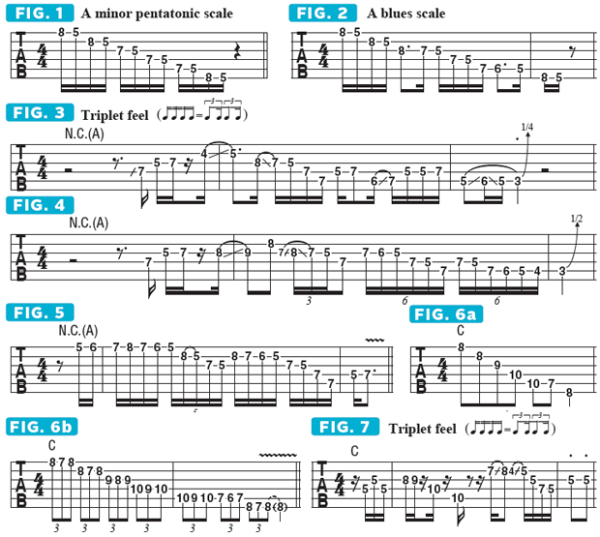Using Chromatic Passing Tones to Add Color to Your Solos
Learn how to incorporate chromatic notes into your solos in this classic Guthrie Govan lesson.
I am often asked how I incorporate chromatic notes into my solos and how I approach playing “outside” the given key center of a song.
If you have ever used the blues scale, then you have already employed chromatic notes in some of the most musical ways possible.
FIGURE 1 shows the A minor pentatonic scale. To get the A blues scale, we simply add Eb, the flatted fifth (f5), as shown in FIGURE 2.
Now, that Eb can sound like the worst note in the world—if you land on it and stop, you’ll be hurting people—but most of us use it as a passing tone, as I do in four spots in FIGURE 3: in the key of A, at the end of bar 1, I slide from Eb up to E, the fifth, which is a nice solid chord tone, and in bar 2, I move from beat one to beat two by sliding down from Eb to D, the fourth.
I use the same concept into beat four and on beat one of the next bar. Here, I use the b5 as an ornament to add “funkiness” to the lines. If you can employ this concept successfully, in theory you know everything you need to know in order to use any one of the 12 notes as a passing tone at any point—as long as you use it responsibly. The safest approach is to follow every jarring, passing note with a “good” note that sits close by melodically.
Moving into a chord tone immediately justifies the jarring note you played right before it. It’s also important that the “good” notes land rhythmically on the more important parts of the beat or groove.
Let’s go back to A minor pentatonic and simply fill in the gaps between the scale tones with most of the available passing tones, as I do in FIGURES 4 and 5. You can also go back to basics and start with chord tones only. FIGURE 6a shows the triadic chord tones for C major: C, G and E, played through three octaves.
FIGURE 6b shows how to add the chromatic “approach note,” or “lower neighbor,” one half step below each chord tone. FIGURE 7 illustrates a typical way to use this concept in a swinging, bluesy line. This approach can be heard in well-known songs like “Politician” by Cream, and Henry Mancini’s “The Pink Panther.”
When people talk about playing “outside,” it’s often just a broader approach to creating lines. Instead of a “wrong” note followed by a “right” note, it’s often the wrong key followed by the right key. In FIGURE 8, I play a long line based around B minor, using as many passing tones as possible but ending up squarely back in B minor.
If you can “get lost” without traveling too far away and then land on your feet, you’ve done a successful job at weaving chromaticism into a solo phrase. The key is to keep your ears wide open and don’t be afraid to explore uncharted musical waters.


Get The Pick Newsletter
All the latest guitar news, interviews, lessons, reviews, deals and more, direct to your inbox!









![Joe Bonamassa [left] wears a deep blue suit and polka-dotted shirt and plays his green refin Strat; the late Irish blues legend Rory Gallagher [right] screams and inflicts some punishment on his heavily worn number one Stratocaster.](https://cdn.mos.cms.futurecdn.net/cw28h7UBcTVfTLs7p7eiLe.jpg)
